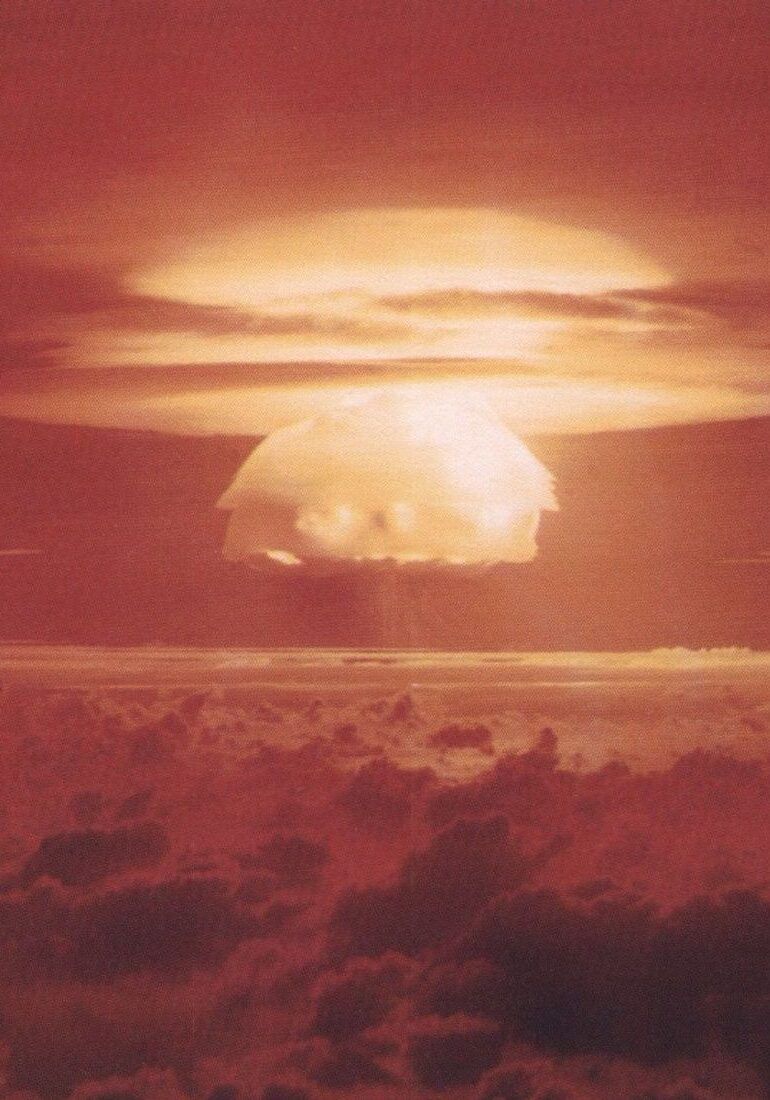
Special Report
The fallout never ended
By Robert Alvarez | February 1, 2024
Decades of nuclear weapons tests and other radioactive experiments injured or killed scientists, soldiers, and innocent bystanders. Many of them, and their relatives, have never been compensated, but new efforts may change that. A former Senate staffer and expert on the US nuclear program looks back at its harmful effects, and how the government addressed them—or didn't.
- Seeking justice for radiation victims of the US nuclear program
- Human radiation experiments and Oppenheimer's “vaudeville”
- The radiation effects of Trinity
- Lewis Strauss, Castle Bravo, and the end of above-ground nuclear testing
- Running shoes on the Senate floor: How US preparations to test nuclear weapons ended
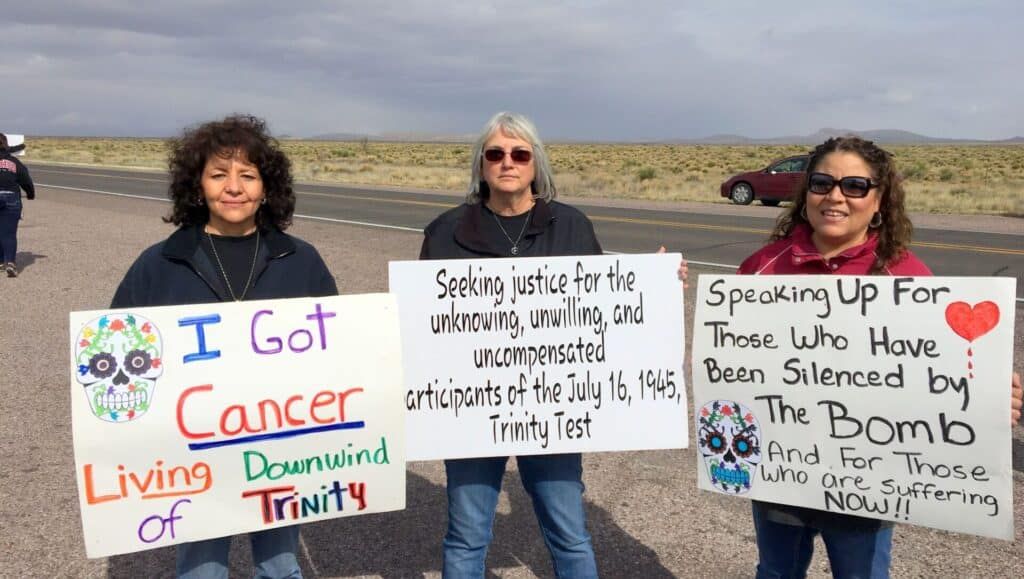
Seeking justice for radiation victims of the US nuclear program
BY ROBERT ALVAREZ
Congress recently decided not to expand the 1990 Radiation Exposure Compensation Act to include several additional Western states (including Trinity Test downwinders in New Mexico), as well as tribal uranium miners and Missouri residents impacted by contamination from illegal dumping of Manhattan Project wastes. As the empirical evidence of the radiological legacy of the Manhattan Project and the early Cold War grows, the Congressional Budget Office puts the price-tag for the expansion of RECA to include victims not accounted for in earlier legislation at $147 billion over the next 10 years.[1]
Despite the price tag and the recent congressional decision not to expand RECA, the effort to gain compensation for more radiation victims is far from dead—especially with elections looming in less than a year. RECA expansion has received unusual bi-partisan support in Congress, especially from members representing “red states” impacted by the early nuclear weapons program. And cancer victims and their families are well organized and not giving up.
RECA is unique in that it offers an explicit congressional apology and financial restitution for placing Americans into harm’s way without their knowledge or consent. As of May 2022, compensation benefits have been paid out to 30,092 Nevada Test Site downwinders and onsite participants, totaling $1.63 billion. Under RECA, 9,098 uranium miners and process workers who worked up to 1971 have received $974 million in compensation benefits, including health care.[2] In terms of the overall compensation picture, an important element of the story is the Energy Employee Occupational Illness Program Compensation Act of 2000. Under this law, 139,973 nuclear weapons workers have been granted $24.45 billion in compensation.[3]
Gen. Leslie Groves, the director of the Manhattan Project, constructed a barrier intended to block legal claims for radiation injuries and illnesses, but it began to crack by the 1980s and now has crumbled. Groves believed that such compensation was a dagger aimed at the heart of the nuclear weapons program. Given widespread radiation exposure problems, concerns over financial and legal liabilities also influenced a wide variety of radiation-protection decisions. According to Stafford Warren, medical advisor to Groves, an overriding concern was to protect “the government interests” against legal claims.[4]
In a memo regarding possible declassification of a study suggesting that occupational radiation exposure levels “may be too high,” the head of the Insurance Branch of the AEC declared:
“We can see the possibility of a shattering effect on the morale of the employees if they become aware that there was substantial reason to question the standards of safety under which they are working. In the hands of labor unions the results of this study would add substance to demands for extra-hazardous pay ... [K]nowledge of the results of this study might increase the number of claims of occupational injury due to radiation.”[5]
The US government spared no expense to fight lawsuits filed by people living close to nuclear testing grounds. Without exception, the courts ruled in favor of the agency then in charge of the country’s nuclear program, the Atomic Energy Commission. Since the US nuclear weapons program controlled all federal research of radiation health effects and kept radiation fallout data behind a curtain of secrecy, the deck was stacked against “down-winders,” who had few resources and no security clearances. It became clear that secrecy, isolation, and privilege had corrupted science and violated the public trust—for the purpose of amassing the world’s largest arsenal of weapons of mass destruction.
By 1987, the overarching legal approach that Groves set during World War II was still alive and well at a meeting of the Health Physics Society that I attended. The main speaker was Brian Seibert, an attorney from the Energy Department who gave a speech titled, “Radiation: the Offense and the Defense.” In a room filled with nuclear industry employees, he prefaced his presentation by declaring “this is the party line” and then proceeded to expatiate on how successful radiation compensation claims would seriously curtail nuclear weapons, nuclear power, and nuclear medicine.
He then introduced the group to Mr. Don Jose, a US Department of Justice litigator, who was to lead workshops sponsored by the society around the country to train health physicists, the people responsible for nuclear health and safety, to become expert witnesses against claimants.
Although his speech was, to say the least, ethically dubious, the Energy Department attorney was correct in saying that compensation for radiation injuries and diseases remains an important force shaping a broad array of technical and policy issues involving medicine, science, public health, energy production, environmental protection, and national security. In addition to helping victims of the government’s various nuclear activities, compensation for illicit exposures of the public to radiation also plays a powerful role in radiation standard setting, economics, and public acceptance of nuclear technologies.
But Americans who were endangered by the government without their knowledge deserve justice and accountability. “What good is it to defend our country with nuclear weapons, if we poison our people?” former Sen. John Glenn often asked. This question still deserves an answer as we come to terms with the human price for unlocking atomic fire.
Notes
[1] NDAA Includes $150 Billion Deficit-Increasing Program, Committee for a Responsible Federal Budget, October 2023. LINK
[2] The Radiation Exposure Compensation Act (RECA): Compensation Related to Exposure to Radiation from Atomic Weapons Testing and Uranium Mining, Congressional Research Service, Table A-1, June 2022. LINK
[3] Department of Labor, Office of Workers' Compensation Programs (OWCP) EEOICP Program Statistics, June 22, 2023. LINK
[4] Barton Hacker, The Dragons Tail, University of California, 1987, p.51.
[5] Report of the President’s Advisory Committee on Human Radiation Experiments, Part II, Chapter 13. LINK
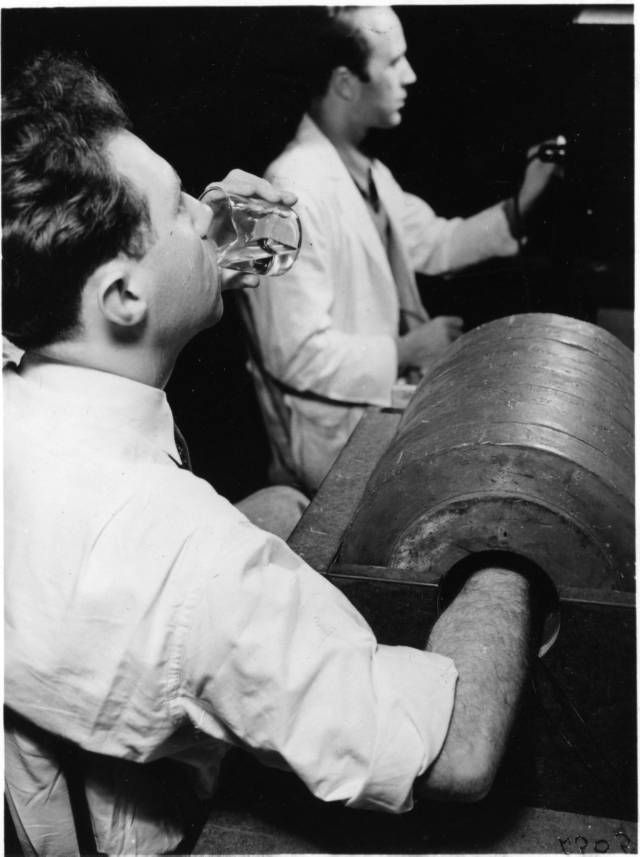
Human radiation experiments and Oppenheimer’s "vaudeville"
BY ROBERT ALVAREZ
J. Robert Oppenheimer’s attitude towards radiation hazards was shaped by the cavalier practices at the Berkeley Radiation Laboratory where some of the United States’ first cyclotrons produced an array of new radioactive elements. In 1935, Oppenheimer and Ernest Lawrence, the lab director, performed an impromptu human radiation experiment for students in which Oppenheimer drank a glass of water containing radioactive sodium.
“He got me out on the platform used me like a guinea pig,” recalled Oppenheimer. “He had me put my hand around a Geiger counter and gave me a glass of water in which part of the salt had radioactive sodium. “In less than a minute, there was a great clattering of the Geiger counter…the salt had diffused from my mouth through my bloodstream to the finger- tips.”[1]
Lawrence repeated this stunt numerous times, as a key part of his lecture circuit, which he described as “vaudeville.” It’s difficult, if not impossible, to calculate the radiation dose from this experiment especially when lab employees were not properly monitored for internal exposures until 1962.[2]
Currently, 266 Berkeley Laboratory workers are officially recognized by the federal government as having cancers following exposure to radiation that are deserving of compensation.[3] Oppenheimer, a heavy smoker, died in 1967 at the age of 62 from laryngeal cancer. Several of Oppenheimer’s colleagues who took part in Lawrence’s radioactive “vaudeville” shows at Berkeley also succumbed to cancer.[4]
Though Oppenheimer may have had a cavalier attitude about radiation exposure, his medical staff recognized potential dangers from handling recently discovered nuclear materials. Tolerance limits and procedures simply did not exist to deal with high-hazard substances such as plutonium.
Robert Stone, the medical Director of the Manhattan Projects’ Health Division underscored the problem of having to make up exposure limits as they went along by observing after the war that “the whole clinical study of the personnel is one vast experiment.”[5]
In the fall of 1944, concerns arose over the possibility that exposure to plutonium[6] might bring about a work stoppage at Los Alamos that could derail the rush to test the first atomic bomb. The Manhattan Project had standard worker compensation insurance, which only covered illnesses or disabilities that appeared within 90 days of an accident or 30 days after leaving the project. But Cyril Stanley Smith, chief metallurgical chemist at Los Alamos and a close personal friend of Oppenheimer, denounced these time limits as “inhumane, unethical and unfair,” as he and his fellow chemists refused to work without extra insurance. Bending to their demand, the US government set up a secret million-dollar fund to keep the plutonium chemists at Los Alamos on the job.[7]
Ordinary workers in the Manhattan Project fared less well. Ted Lombard was an enlisted man in the US Army assigned to work at Los Alamos during the war. After the badges meant to measure exposures were turned over to an officer “we would proceed to unload uranium and plutonium barehanded . . . the fumes and dust were constantly in the air; there was no ventilation system. The dust was on the floor. Uranium chips would be in your shoes that you continued to wear. You went to eat with the same clothes on. You went to the barracks with the same clothes and sat on the beds.”
By 1980, Ted Lombard was suffering from fibrosis of the lungs and severe bone marrow damage. When Lombard filed a claim with the US Department of Veterans Affairs, he was denied repeatedly on the grounds that his medical and exposure records were lost. [8]
A bare-bones safety staff was expected to come-up with exposure limits on the fly as the project proceeded at Los Alamos. Oppenheimer quickly realized that the lab needed to establish a human experiment program to deal with one of their most pressing concerns—handling large amounts of plutonium. Acting with Oppenheimer’s approval, Louis Hempelman, the Los Alamos medical director, got the Manhattan Project to “undertake human experiments to measure the excretion patterns of plutonium.”[9] After a military medical officer balked for ethical reasons, he was given a direct military order to administer the first human plutonium injection on April 10, 1945, at the Oak Ridge Hospital.
All told, average plutonium doses about 310 times larger than the current annual limit for workers were injected into the veins of 18 men women and a child ranging from 4 to 69 years of age in Rochester, NY, New York City, Oakridge, TN and San Francisco, CA.[10] The patients were never told about the implications of these experiments. They received no special surveillance treatment or care. The purpose of the experiment was to develop information on how plutonium behaved inside the body. From these experiments came a metabolism formula for Plutonium-239 known as the "Langham Equations", named after Dr. Wright Langham, formerly of Los Alamos Labs.[11]
Although the patients injected with plutonium were considered to have terminal diseases, they did not die when predicted. In 1975, the Energy Research and Development Administration (ERDA) issued a report prepared by the Argonne and Lawrence Livermore Labs which identified 17 out of the 18 participants. Eight survived for at least 8 years following the injections. There were no therapeutic benefits derived from the plutonium injections. [12]
After the war, between the early 1950s and early ‘60s, 23 human radiation experiments were conducted by Los Alamos.[13] Most were done in support of nuclear weapons production and testing. Informed consent was often trumped by military secrecy. For instance, during the 1955 and 1956 nuclear weapons test series, manned B-57 Airforce bombers were sent into radioactive mushroom clouds. To determine “how much air space was excluded for follow-on strikes [with nuclear weapons] by manned aircraft" during combat operations, the bombers made 27 “penetrations” through the radioactive clouds giving off a potentially lethal dose rate of 800 rads per hour.[14]
Ruth Faden, a bioethicist at Johns Hopkins University and chair of the presidential advisory committee that assessed the experiments, concluded, “What most troubled the committee was the lack of respect for the American people that seemed to permeate the conduct of the research. The period [1940-1974] we examined was defined by arrogance. People had trust in their doctors, but the doctors who did the research often took advantage of that trust.”[15]
Notes
[1] Angela N. H. Creager, Life Atomic: A History of Radioisotopes in Science and Medicine, University of Chicago Press, p 33.
[2] National Institute for Occupational Safety and Health, Advisory Board on Radiation and Worker]Health, “Method to Assess Internal Dose Using Gross Alpha, Beta, and Gamma Bioassay and Air Sampling at the Lawrence Berkeley National Laboratory” April 2018, p 6. LINK
[3] Department of Labor, Office of Worker Compensation Programs, Lawrence Berkeley National Laboratory – California, Program Statistics, September 19, 2023. LINK
[4] They include: Luis Walter Alvarez, died in 1988, age 77, from esophageal cancer; Joseph G. Hamilton, died in 1957, age 49, from leukemia; and Joseph W. Kennedy, died in 1957, age 40, from stomach cancer.
[5] Robert S.. Stone, “Health Protection Activities of the Manhattan Project,” Proceedings of the American Philosophy Society,” Vol. 90, no. 1, January 1948, pp 11-19.
[6] Barton Hacker, The Dragons Tail, University of California Press, (1987), p 55.
[7] Department of Energy, Manhattan District History: The Los Alamos Project, Vol. I. Inception Until August 1945 (1961), p 51. LINK
[8] National Committee for Radiation Victims, National Citizen Hearing, Statement of Ted Lombard, April 1980.
[9] U.S. Department of Energy,, Human Radiation Experiments; the Department of Energy Road Map to the Story and Records, DOE/EH-0445, February 1995, p.136.
[10] Personal communication with Karl Z. Morgan November 10, 1980.
[11] L. H. Hempelmann, W. H. Langham, C. R. Richmond, and G. L. Voelz. 1973. Manhattan Project plutonium workers: A twenty-seven year follow-up study of selected cases. Health Physics 25: 461-47.
[12] Robert Alvarez, memorandum to Karen Wilson, Director National Committee for Radiation Victims, Subject: Federally-Sponsored Human Experiments Involving Ionizing Radiation, February 21, 1981.
[13] Op Cit Ref 6, pp 251-259.
[14] Walter Pincus. Air Crews Measured Radiation by Flying through A-Bomb Clouds, Washington Post, November 14, 1985.
[15] Gary Lee, Clinton Apologizes for U.S. Radiation Tests, Praises Panel Report, Washington Post, October 4, 1995.
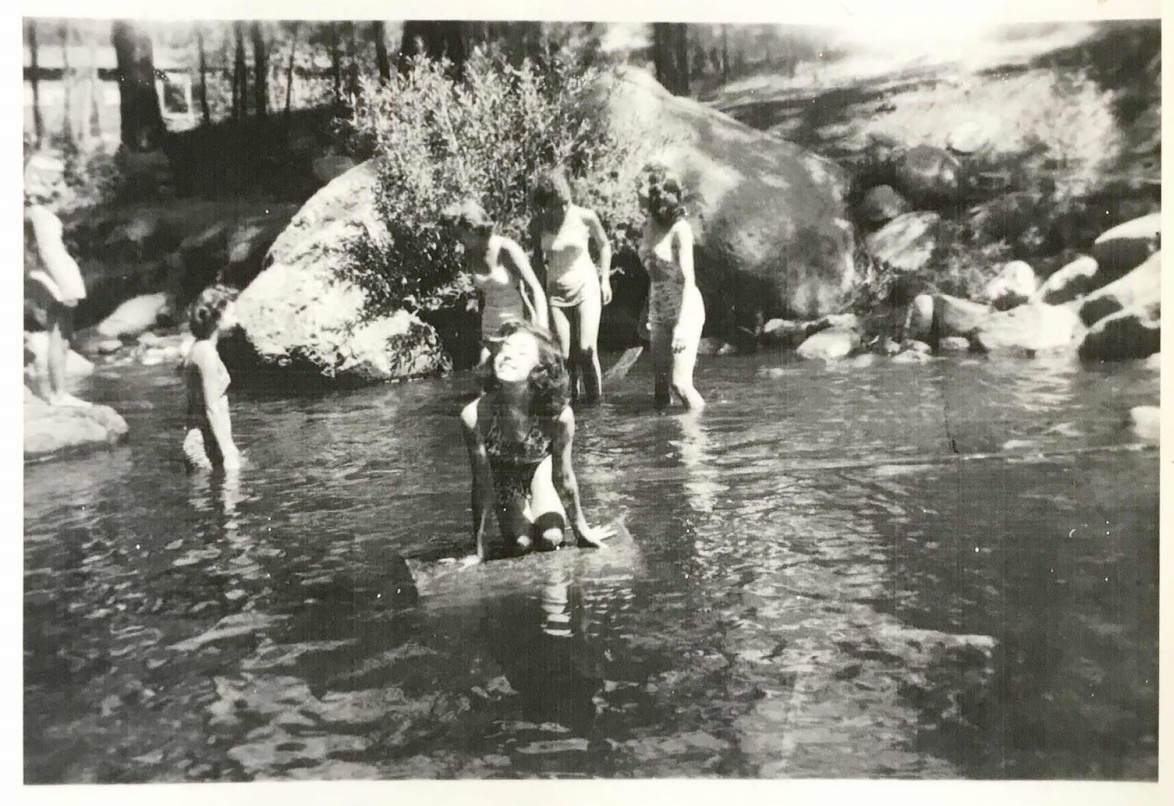
The radiation effects of Trinity
BY ROBERT ALVAREZ
For decades, the assertion that “we were lucky” in the radiological aftermath of the world’s first nuclear explosion on July 16, 1945, named Trinity, has taken on a folklore status. “The only reason the Trinity test did not irradiate 100,000 people was because of a shift in the wind,” Jack Detsch and Ausha Rathl recently wrote in Foreign Policy magazine. “One wrong gust, and radioactive dust would have blanketed Albuquerque and Santa Fe.”[1] Even if true, this anecdote misses the more important point: The radiological consequences from the world’s first nuclear weapon explosion were large and knowledge of their extent continues to unfold.
Scientists—including Oppenheimer—recognized the hazards of radioactive fallout several years before the Trinity test. “Owing to the spread of radioactive substances with the wind, the bomb could probably not be used without killing large numbers of civilians, and this may make it unsuitable as a weapon for use by this country,” physicists Otto Frisch and Rudolf Peierls warned in their important memorandum of March 1940.[2]
In their statement opposing deployment of the H-Bomb in October 1949, Oppenheimer and fellow members of the Atomic Energy Commission’s (AEC) General Advisory Committee made clear that the existential threat posed by radioactive fallout was definitely on their minds. “We are alarmed as to the possible global effects of the radioactivity generated by the explosion of a few super bombs of conceivable magnitude.”[3] Oppenheimer and his colleagues were stating a scientific consensus reached at the Los Alamos Laboratory by 1945 [4] Soon after President Truman overruled Oppenheimer and his colleagues, Albert Einstein warned the public in more direct terms, stating that “radioactive poisoning of the atmosphere and hence annihilation of any life on Earth has been brought into the realm of technical possibilities.”[5]
By the time that Oppenheimer was banished from government service in 1954, the nuclear weapons program had a secret human experiment underway involving the surreptitious collection of human tissues from across the globe, so as to determine how many open-air nuclear explosions could render the Earth uninhabitable.[6] Since then, atmospheric nuclear weapons tests conducted between 1945 and 1963 have resulted in “ by far the greatest exposure of mankind to ionizing radiation.”[7]
Seventy-four years after Trinity, my wife and I published evidence indicating that the first victims of the first nuclear explosion might have been America's children.[8] Based on New Mexico’s health data, we discovered an unusual excess of infant deaths following the Trinity detonation. From 1940 through 1960, infant mortality rates in New Mexico dramatically declined each year—except for 1945, when the death rate significantly exceeded all other years (Figure 1).
Infant death rates were especially elevated during the three months after the Trinity detonation, when the largest doses from external radiation and iodine 131 are estimated to have occurred.[9] The risk of children dying throughout New Mexico increased by 56 percent during the first three months after the explosion. The chance that this increased risk was due to a random fluctuation is 0.0007 percent. (See Figure 2.)
Iodine 131 exposures to children: Exposures from inhalation and ingestion of water and food contaminated by Trinity test fallout were never assessed—until October of 2020, when the National Cancer Institute published its fallout dose reconstruction study.[10] Of particular concern are exposures to pregnant mothers, infants, and small children to iodine 131. With a half-life of 8.02 days, iodine 131 is responsible for about 80 percent of the internal organ dose from nuclear weapons fallout[11] and is among the most hazardous isotopes, because it rapidly concentrates in vegetation and especially milk products. Since it is absorbed mostly in the body’s thyroid gland, radioactive iodine has been linked to thyroid cancer and other types of thyroid disease.
Vulnerability of children to I-131 has been well established for decades. “The reason that radioiodine is so dangerous in children is that their normal growth and development, especially of the brain, depends on the thyroid gland,” says Alan H. Lockwood, professor of neurology and nuclear medicine at the University of Buffalo School of Medicine and Biomedical Sciences.[12]
There are large uncertainties in the dose estimates of the NCI’s study, which are based on retrospective estimation of consumption rates and assumptions about the contamination of the ingested food 70 years after the fact. Essential elements that are missing or obscured in the NCI study of the Trinity test were given prominence in the institute’s 1997 study of fallout from the Nevada Test Site.[13] Among the most significant are the implications of Trinity fallout doses for pregnant mothers, infants and small children.
Data buried in the appendix of the cancer institute’s Trinity study indicate that several thousand infants and small children in 26 out of 33 of New Mexico’s counties, especially the major cities, absorbed average thyroid doses in excess of long-standing federal guidance[14] protecting infants from environmental exposure to radioactive iodine (100 millirems).[15]
Children in nine counties, including in the cities of Albuquerque and Santa Fe, are estimated to have received thyroid doses above 1,000 millirems[16]—a dose for which the World Health Organization recommends the prompt use of potassium iodine to block the uptake of radioactive iodine. Five counties, including the city of Albuquerque, received thyroid doses that are close to or greater than those linked to a significant risk of childhood thyroid cancers among children exposed to fallout from the Chernobyl accident (approximately 5,000 millirems).[17] Even though these protective measures are “guardrails” based on scientific evidence of harmful effects, they are absent in the NCI’s discussion of risk in the context for the most vulnerable.
A 2002 study by the Agency for Toxic Substances Disease Registry of mothers and children exposed to releases of iodine 131 at the Hanford nuclear production complex in Washington state, reported a significant exposure-related risk of pre-term birth problems as well as a suggestion of infant deaths linked to the Hanford releases.[18]
The statistical correlation of excess infants deaths with the Trinity blast raises a critical question as to where the burden of proof should lie in terms of compensating those affected, especially given the mendacious conduct by the US nuclear weapons program. The record is extensive and clear that in order to prosecute the nuclear arms race, the US government willfully deceived the public about the nature and extent of harm that could be caused by radioactive fallout.
We discovered correspondence showing that medical experts with the Manhattan Project engaged in deception and misrepresentation of health data when confronted with concerns by a local health care provider over an unusual number of infant deaths in Roswell, New Mexico shortly after the Trinity blast. After claiming to have reviewed New Mexico’s unpublished data (when they actually didn’t possess it), the Manhattan Project medical experts declared that nothing untoward had occurred. However, the unpublished hand-written data which was finally provided to the Los Alamos health experts in 1948 revealed that the infant death rate was 38 percent higher in 1945 than in 1946 and was 57 percent higher than in 1947. [19]
***
Warning the public about the manifestly dangerous Trinity experiment took a back seat to producing the first atomic bombs. In the end, the scientific director of the Los Alamos lab where the atomic bombs were created, J. Robert Oppenheimer, deferred to the military when it came to public safety and key policy decisions about use of the bombs. Alvin Weinberg, director of Oak Ridge Laboratory during and after the Manhattan Project, captured the mindset, explaining that it was shared by leaders who believed that “all else including safety, was secondary.”[20]
After being informed a month before the test by physicist Joseph Hirschfelder that radioactive fallout from the Trinity test might be a larger problem than assumed, Oppenheimer kicked the problem up to the overall director of the Manhattan Project, Gen. Leslie Groves. To avoid potential legal liabilities, Groves reluctantly agreed to dispatch a team to track the deposition of radioactive material from the bomb cloud. That effort turned out to be too little, too late.
The 24.8 kiloton Trinity explosion occurred on a tower 100 feet above the ground and has been likened to a “dirty bomb,” casting large amounts of heavily contaminated soil and debris that contained 80 percent of the bomb’s unfissioned plutonium over 46 states, and Canada.[21]
Five days after the explosion, Stafford Warren, head of radiation safety for the test, reported to Groves that “a very serious hazard” existed over a 2,700-square-mile area downwind from the test—an area 70 times greater than the 38.5 square miles predicted by Los Alamos scientists before the explosion. In 2010, the US Centers for Disease Control and Prevention underscored Warren’s assessment by concluding that “exposure rates in public areas from the world’s first nuclear explosion were measured at levels 10,000 times higher than currently allowed.”[22]
In a matter of weeks, Oppenheimer and Groves were made aware by the Eastman-Kodak company that fallout containing radioactive particles from the Trinity detonation had fogged its X-ray film stock via contaminated cardboard packages. River water and straw used in making the cardboard had been radioactively contaminated at high levels—1,254 miles away from the test, at a facility near Vincennes, Indiana.[23] The government took prompt action to warn Eastman-Kodak, a prime Manhattan Project contractor, about pending future bomb tests.
Meanwhile, after 75 years, justice is long overdue for thousands of down-winders who were never warned about the poisonous radioactive clouds created by the first nuclear bomb explosion.
Notes
[1] Jack Detsch and Ausha Rathl, The Long Shadow of Oppenheimer’s Trinty Test, Foreign Policy, July 23, 2023. LINK
[2] Otto Frisch and Rudolf Peierls, Memorandum on the Properties of a Radioactive “Super-bomb,” March, 1940.
[3] General Advisory Committee's Majority and Minority Reports on Building the H-Bomb, October 30, 1949. LINK
[4] Manhattan District History Project Y. 1961. “Los Alamos Project, LAMS-2531, Vol. I.” December, 1961, p 55. LINK
[5] Albert Einstein, “Arms Can Bring No Security." Bulletin of the Atomic Scientists, 6(3), p. 71
[6] Robert Alvarez & Joseph Mangano (2021) I gave my baby tooth to science: Project Sunshine’s role in the Limited Test Ban Treaty and cutting-edge pollution research, Bulletin of the Atomic Scientists, 77:6, 312-317. LINK
[7] Korblein A (2023) Statistical modeling of trends in infant mortality after atmospheric nuclear weapons testing. PLoS ONE 18(5). LINK
[8] Katheen Tucker and Robert Alvarez, Trinity: “The most significant hazard of the entire Manhattan Project” The Bulletin of Atomic Scientists, July 15, 2019. LINK
[9] National Cancer Institute, Estimated Radiation Doses Received by New Mexico Residents from the 1945 Trinity Nuclear Test, Health Physics, 2020 Oct; 119(4): 428–477. LINK
[10] National Cancer Institute, Estimated Radiation Doses Received by New Mexico Residents from the 1945 Trinity Nuclear Test, Health Physics, 2020 Oct; 119(4): 428–477. LINK
[11] Centers for Disease Control, Feasibility Study of Weapons Test Fallout, Chapter 3. (2000), LINK
[12] Ellen Goldbaum, Iodine-131 exposure puts children's normal growth and development at risk, says UB radiation expert, March 2011. University of Buffalo News Center. LINK
[13] For instance, the 1997 NCI study provides details regarding the total amount of iodine 131 released (150 million curies) whereas it's absent from the Trinity study. The 1997 study provides a default estimate of 150,000 Curies per kiloton yield of a nuclear explosion. When applied to the Trinity test, such an estimate implies that 3,720,000 curies of iodine 131 was released. This is roughly comparable to the amount released by the Fukushima accident.
[14] U.S. EPA, Protective Action guides and Planning Guidance for Radiological Incidents, January 2017, p 56.
[15] Op Cit Ref. 2, Tables 1 and 2.
[16] They include Torrance(21,000 mr), Socorro (2,100 mr), Bernadillo-Albuquerque (4,500mr), Colfax(1,300mr) Mora (1,200), Santa Fe (2000 mr), San Miguel (5,600mr), Lincoln (5,5000mr) and Guadalupe 25,000mr).
[17] U.S. Department of Health and Human Services, Food and Drug Administration Center for Drug Evaluation and Research (CDER), Guidance, Potassium Iodide as a Thyroid blocking Agent in Radiation Emergencies, December 2001, p 2. LINK
[18] Tatham LM, Bove FJ, Kaye WE, Spengler RF. Population exposures to I-131 releases from Hanford Nuclear Reservation and preterm birth, infant mortality, and fetal deaths. Int J Hyg Environ Health. 2002 Mar;205(1-2):41-8. doi: 10.1078/1438-4639-00128. PMID: 12018015.
[19] Op Cit Ref. 7.
[20] Alvin M. Weinberg, The First Nuclear Era: The Life and Times of a Technological Fixer, The American Institute of Physics, New York (1994), p 188.
[21] Sébastien Philippe,, Susan Alzner, Gilbert P. Compo, Mason Grimshaw, Megan Smith, Fallout from U.S. atmospheric nuclear tests in New Mexico and Nevada (1945-1962), Program on Science and Global Security, Princeton University, Princeton, New Jersey, July 23,2023. LINK
[22] Centers for Disease Control, Final report of the Los Alamos Historical Document Retrieval and Assessment (LAHDRA) Project, November 2010, p ES-32.
[23] Matt Blintz, When Kodak Accidentally Discovered A-Bomb Testing, Popular Mechanics, June 20, 2016. LINK
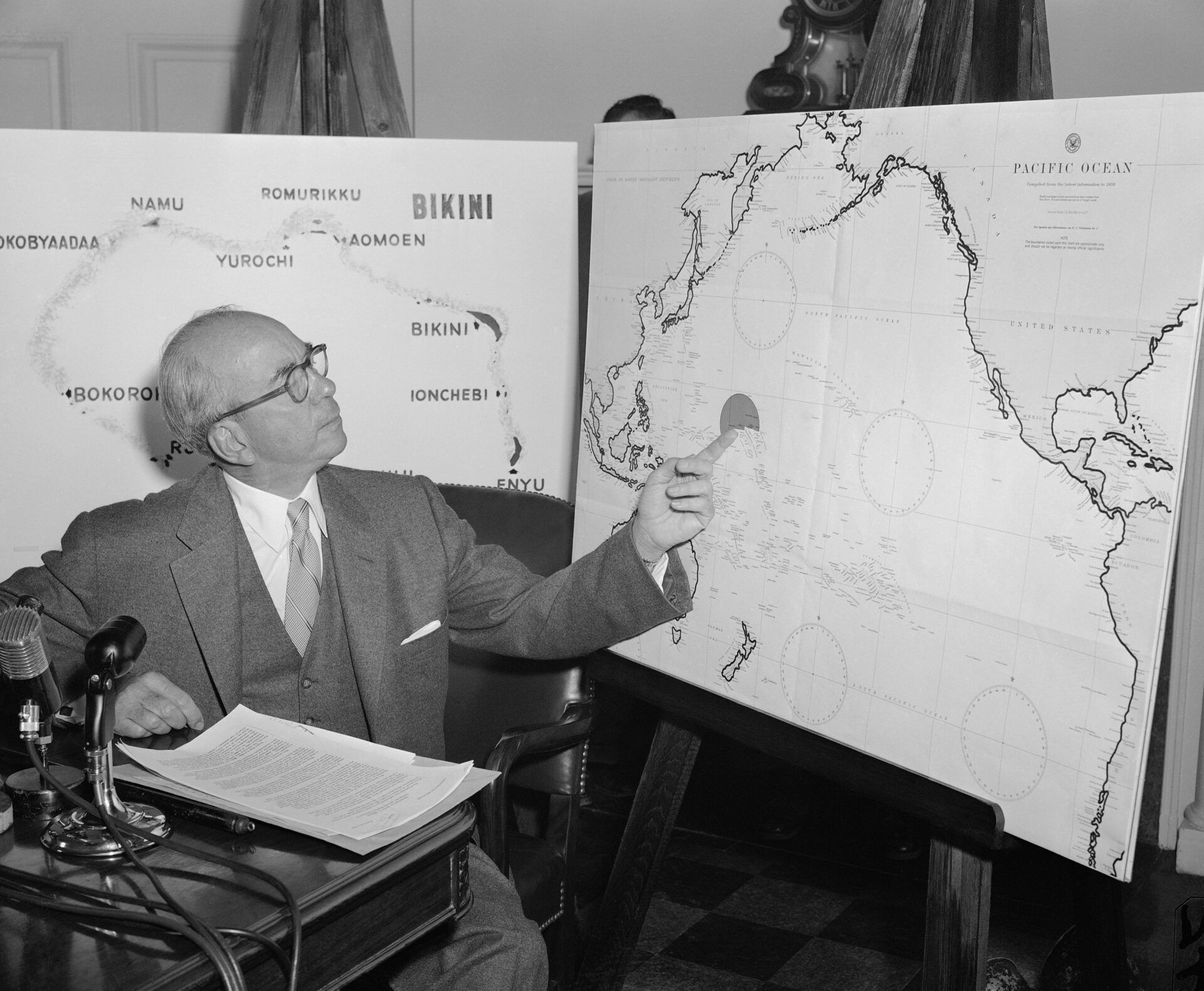
Lewis Strauss, Castle Bravo, and the end of above-ground nuclear testing
BY ROBERT ALVAREZ
As Lewis Strauss, chairman of the US Atomic Energy Commission, was orchestrating Oppenheimer’s banishment from the nuclear weapons establishment in the spring of 1954, he was facing what would be, according to the US Radiochemistry Society, the “worst radiological disaster in US history.”[1]
On March 1, 1954, three days before Oppenheimer demanded a security clearance hearing, the United States detonated a 15 megaton H-bomb in the Marshall Islands; the test was known as “Bravo.” It was the first of six H-bomb detonations, totaling about 48 megatons, that made up the “Castle” test series. About five hours after the detonation, intense fallout severely contaminated a Japanese commercial fishing boat, Fukuru Maru (the Lucky Dragon), which was some 90 miles from the Bikini explosion, along with the atolls of Rongelap, Alinginea, Rongerik, and Utirik, which were about 200 miles away. At the end of September, a crew member of the “Lucky Dragon” died from acute radiation syndrome.
Dozens of people in the Rongelap and Uterik atolls suffered severe and immediate impacts after receiving life-threatening radiation doses comparable to those afflicting Japanese atomic bomb survivors. Fallout was so heavy that people who had never seen snow thought it was snowing. Children played in the radioactive powder and were, shortly thereafter, showing symptoms of acute exposure, such as loss of hair, radiation burns, and vomiting. It was two days before the US Navy put them on ships to be decontaminated and evacuated to a safer atoll.
With approximately 3,200 times the destructive power of the Hiroshima bomb, the Castle tests’ lethal fallout compelled the AEC to dramatically increase the size of the Marshall Islands “danger zone” from 67,000 square miles to 570,000 square miles—approximately twice the size of Texas. But according to the Energy Department’s official history, “Castle’s long-term implications for politics, international relations, and, ultimately, humanity in general were even greater.”
In the midst of the Oppenheimer security hearing, Strauss made a series of false and misleading statements about the aftermath of the Bravo test. Those statements would play no small role in the US Senate voting against his nomination for Commerce Secretary. Strauss declared on March 3, 1954 that “236 natives appeared to me to be well and happy" and that medical personnel had advised that “they anticipate no illness.” Strauss went further to state that the American public was exposed to a “small increase” in radiation that was “far below the levels which could be harmful in any way.”
Meanwhile, top scientists advising the Atomic Energy Commission that Strauss chaired were informed in July 1954 that fallout from Bravo and five other H-bomb detonations from the “Castle” test series “had been very large [and] was expected to show up in vegetation and food by Thanksgiving."
Three weeks before Thanksgiving of that year, the AEC’s General Advisory Committee met again. John Bugher, the head of the AEC’s Division of Biology and Medicine, reported that “[a]fter one of the big shots iodine 131 can be picked up anywhere in the world … I 131 can be detected in thyroids all over the US.” Bugher stated that “everyone in the US [160 million people] received a dose of 1 rep[2] [830 millirems] to the thyroid as a result of Castle.” He also cautioned against the use of milk in heavily contaminated areas. The Bravo test alone released roughly 1.4 billion curies of radioactive iodine, most of which shot up to the stratosphere, contaminating the planet. That single nuclear test dwarfs the combined amounts of radioiodine released by Chernobyl and Fukushima—by 30 times. Moreover, the Bravo explosion poisoned the atmosphere with nearly 10 times more iodine 131 than 100 open-air bomb tests spanning 12 years at the Nevada Test Site.
However, the public was kept in the dark and dissent was not tolerated. Purging the “father of the atomic bomb” from the nuclear weapons establishment in 1954 sent a chilling message to scientists dependent on the Atomic Energy Commission for their livelihood: Challenging nuclear testing could be a career-ending gesture.
Karl Z. Morgan, founder and director of the Atomic Energy Commission’s Oak Ridge Health Physics Lab reflected on how Oppenheimer’s banishment fostered a culture inside the AEC whereby “it became unpatriotic and perhaps unscientific to suggest that atomic weapons testing might cause deaths throughout the world from fallout.”[3]
Historian Lawrence S. Witmer makes it clear what the nature and extent of opposition to nuclear testing was all about. “Recognizing that these nuclear tests were not only paving the way for mass destruction in the future, but were already beginning to generate sickness and death, large numbers of people around the world began to resist… [P]ressures even developed within communist dictatorships. In the Soviet Union, top scientists, led by Andrei Sakharov, appealed to Soviet leaders to halt nuclear tests.”
Polls conducted in 1957 and 1958 showed that respondents from several nations— including 63 percent of Americans—expressed strong support for a ban on nuclear testing. Behind the scenes, the Bravo test prompted President Eisenhower to support a testing moratorium, which Strauss and the military effectively thwarted. In 1956, the AEC and the Armed Forces Special Weapons Project (AFSWP) began
an effort to develop a “clean” H-Bomb by limiting the injection of radioactivity from H-bombs tests into the stratosphere so as “to increase the local fallout in an effort to reduce thereby worldwide contamination.”
Strauss’ string of falsehoods and his unyielding support for nuclear testing made him an object of public opprobrium. At his nomination hearing before the Senate Commerce Committee, Strauss’s “many misstatements” regarding the Bravo test were detailed by David L. Hill, president of the Federation of American Scientists. His testimony proved to be devastating. "Not only were the American people denied access to data pertaining to a matter of global public health, but the AEC preempted the authority to evaluate the hazards engendered by its promotion of bomb tests,” Hill concluded.[4] On June 5, 1959, the US Senate debated and later voted by a slim margin to reject Strauss’s nomination to be Secretary of Commerce. In a joint statement, five Democratic Senators, citing Hill, condemned Strauss by stating that:
“Mr. Strauss has shown a willingness to seek to fit the facts to his preconceived notions as regards the fallout danger (hearing, pp. 433 and 728) and the ability to detect bomb tests (hearings, pp. 441 and 558.)”
Regardless of efforts by Strauss to assure the public, his credibility and that of the AEC sank like stones. His reputation never recovered from the Bravo disaster, which helped collapse public support for open-air nuclear testing and set the stage for his career-ending blow. Strauss’s repudiation was final after the signing of the treaty banning atmospheric nuclear testing in 1963.
Notes
[1] Bravo" Both Triumphs and Fails, Atomic Archives.com, 2023. LINK
[2] Röntgen equivalent physical or rep is a unit of absorbed dose used at the time and since replaced with other terminology.
[3] Karl Z. Morgan, "History of Developments in Nuclear Safety and the Development of International Standards," unpublished article submitted to Energy Department's Office of Consumer Affairs, December 1980, p 2.
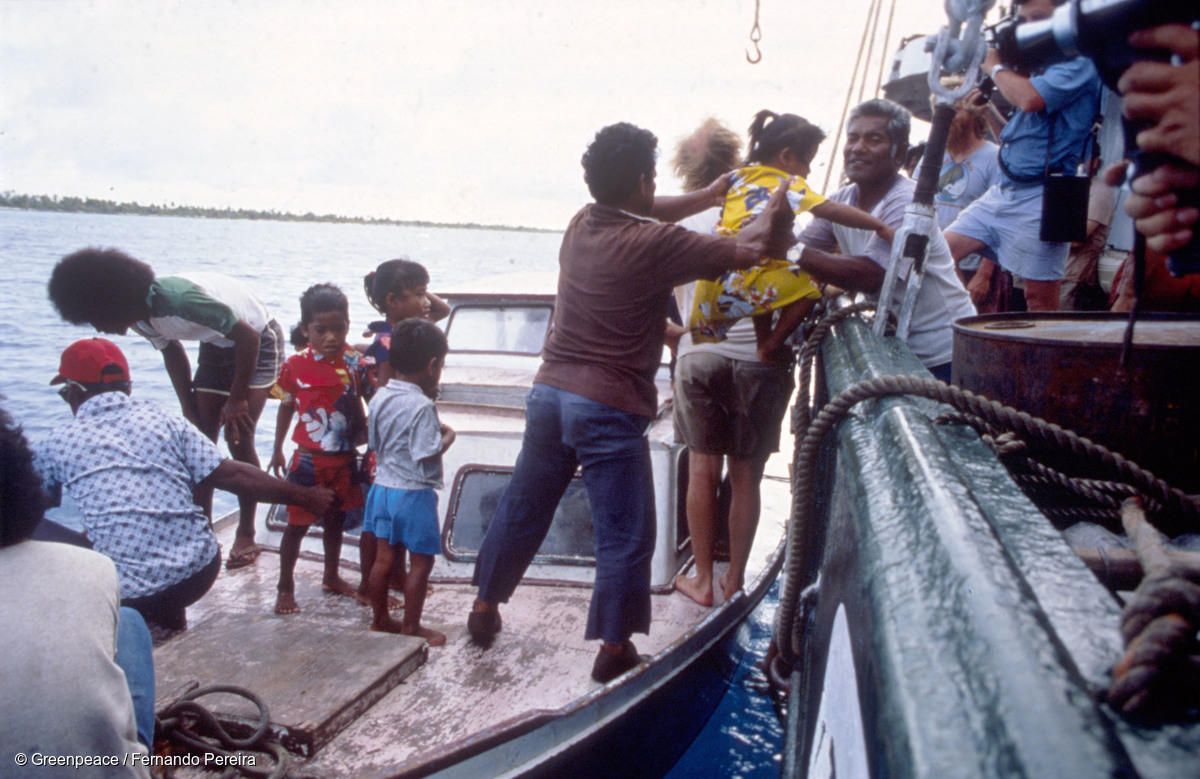
Running shoes on the Senate floor: How US preparations to test nuclear weapons ended
BY ROBERT ALVAREZ
There was an important vote coming up that day in June 1992 on the floor of the US Senate. My boss, Sen. John Glenn (D-OH), was offering an amendment to the Defense Authorization Act that would terminate the Safeguard C readiness program. Safeguard C was meant to enable the United States to quickly resume atmospheric nuclear weapons testing if necessary, whether in the Pacific or at the country’s nuclear test site in Nevada. Glenn’s amendment followed a year-long investigation I had conducted as a staff member for the US Senate Committee on Governmental Affairs regarding the conduct of the US nuclear weapons program in the Marshall Islands.
The radiological legacy of US nuclear weapons testing in the Marshall Islands remains today and will persist for many years to come. The most severe effects were visited upon the people of the Rongelap atoll in 1954, following a very large thermonuclear explosion in the Bravo test series that deposited life-threatening quantities of radioactive fallout on their homeland. They received more than three times the estimated external dose delivered to the most heavily exposed people living near the Chernobyl nuclear accident in 1986.
Many Rongelap residents suffered from tissue-destructive effects of radiation and subsequent radiation-induced diseases. After being evacuated for a time, in 1957, they were returned to their homeland—even though officials and scientists working for the US Atomic Energy Commission (AEC) had determined that radiation doses would significantly exceed those allowed for citizens of the United States. The desire to study humans living in a radiation-contaminated environment appeared to be a major element of the decision to allow the Rongelap people to return home. In a transcript of a previously secret meeting where it was decided to return the Rongelap people to their atoll, a scientist stated that an island contaminated by the 1954 H-Bomb tests (apparently a reference to the Rongelap atoll) was “by far the most contaminated place in the world.”
He further concluded that, “it would be very interesting to go back and get good environmental data … so as to get a measure of the human uptake, when people live in a contaminated environment… Now, data of this type has never been available. While it is true that these people do not live, I would say, the way Westerners do, civilized people, it is nevertheless also true that they are more like us than the mice.” [Emphasis added.]
In 1985, the people of Rongelap fled their atoll after discovering a suppressed Energy Department study done in 1978 that found that the levels of contamination in their homeland were comparable to the Bikini atoll, where numerous nuclear devices had detonated. The Bikini people were returned home in 1969 but had to evacuate again in 1978 after radiation exposures were found to be excessive.
The Rongelap people fled for good reason. In 1982, during the closing phase of negotiations between the United States and the nascent Republic of the Marshall Islands over a Compact of Free Association, the Energy Department secretly established a policy to eliminate radiation protection standards, so as to not interfere with the potential resumption of weapons testing in the Marshalls.
In the fall of 1982, the US Energy Department placed the Marshall Islands health and environmental research program under the direct control of the Energy Department’s nuclear weapons program. At the time, the United States nuclear arsenal was undergoing a steep buildup. As part of this effort, the readiness capability established in 1963 to resume atmospheric nuclear weapons testing in the Pacific region, known as Safeguard C, was given a high priority. In this regard, the Marshall Islands medical and environmental programs became part of the Safeguard C readiness program.[1]
Once under the control of the Safeguard C program in the Department of Energy's Office of Defense programs, key policies and practices were quietly terminated—most notably the adherence to previously adopted radiation exposure standards for the cleanup of the atolls and restrictions on the consumption of contaminated foods. Instead, the Energy Department advised that radiation protection should be based on choices made by the people of the Marshall Islands about the risks and benefits of eating local food—as explained by the Energy Department.
Without radiation exposure standards, Rongelap people began eating local food—and receiving sudden and alarming increases in radiation. These circumstances were uncovered in 1991 by the Committee on Governmental Affairs, which was chaired by Senator Glenn and where I served as senior investigator.[2]
Glenn was particularly interested in our findings, since his first combat as a young Marine fighter pilot was over Rongelap during World War II, providing air support for troops and natives fighting the Japanese. Before the vote on an amendment to eliminate the United States’ preparations for new atmospheric nuclear testing, he convinced the Energy Department to reinstate the food restrictions and to establish the same radiation protection standards on Rongelap as for Americans.
That afternoon, I briefed Glenn ahead of the vote. As I sat in front of his desk, he pulled out a personal note from a fellow senator and read it out loud. “It’s time to rein in that Alvarez guy,” it said. “John, he’s going way beyond your headlights.” His face then lit up in a grin, as he crumpled the note and tossed it in the trash can. “Let’s go do this,” he said.
But in my haste to get to work that day, I left the house wearing my usual coat and tie but absent-mindedly also wearing my running shoes. Very soon after taking my seat with staff on the Senate floor, a person working for the sargeant at arms came up in a state of distress. “You have to leave immediately,” he declared in a polite southern drawl. “Running shoes are forbidden on the senate floor.”
After I protested, he replied matter-of-factly, “If we let you wear running shoes, then the next thing you know, the gals will do the same, and this will destroy the decorum.” I reminded him of the era when spittoons were everywhere on the floor of this august body. He then dropped his polite tone and threatened to summon the Capitol Police.
I relented and ran back to my office in the Dirksen Building and confiscated a pair of well-worn, over-sized brown loafers from an EPA detailee. When I rushed back, it was all for naught. The managers of the Defense Authorization bill accepted Senator Glenn’s amendment without debate. After 45 years, the program that aimed to keep the United States ready to resume atmospheric nuclear weapons testing was finally stricken from the books. The ban on running shoes was lifted some 25 years later, after women senators brought about this change.
Notes
[1] In an undated memo written sometime before the program was transferred in the fall of 1982, Dr. Charles Edington of the DOE’s Office of Health and Environmental Research denounced this move: “It is ludicrous to claim that the Marshall Islands program is an exercise in the expeditionary capability of the Safeguard C program and is related to U.S. capabilities to resume atmospheric testing… health Such statements, if available to the press or the government of the Marshall Islands would destroy whatever credibility the U.S. enjoys in the Marshalls and probably force the termination of the program… Such statements also lend credence to the claim that the U.S. is studying the Marshallese as ‘guinea pigs’…Linkage of the medical and environmental programs to possible resumption of atmospheric testing (implied to occur in the Marshalls) would lead to extreme political embarrassment in the status negotiations, the U.N. and the national and world press… Association of the health care and radiological monitoring programs to the weapons program and readiness capability destroys any pretense of objectivity and credibility.”
[2] By terminating the radiation exposure standards, the US government had regressed to a 1950’s-era policy adopted to allow their return the people of Rongelap to their homeland in 1957—namely that radiation protection standards for the American public were inappropriate for the Marshall Island population and that such use “could establish an undesirable precedent for other situations of environmental contamination from nuclear explosives.”
Robert Alvarez
An Associate Fellow at the Institute for Policy Studies, Robert Alvarez served as senior policy adviser to the Energy Department's secretary from 1993 to 1999. Before joining... Read More
Keywords: Castle Bravo, J. Robert Oppenheimer, John Glenn, Lewis Strauss, RECA, Trinity, downwinders, nuclear tests, radiation
Topics: Nuclear Risk, Nuclear Weapons
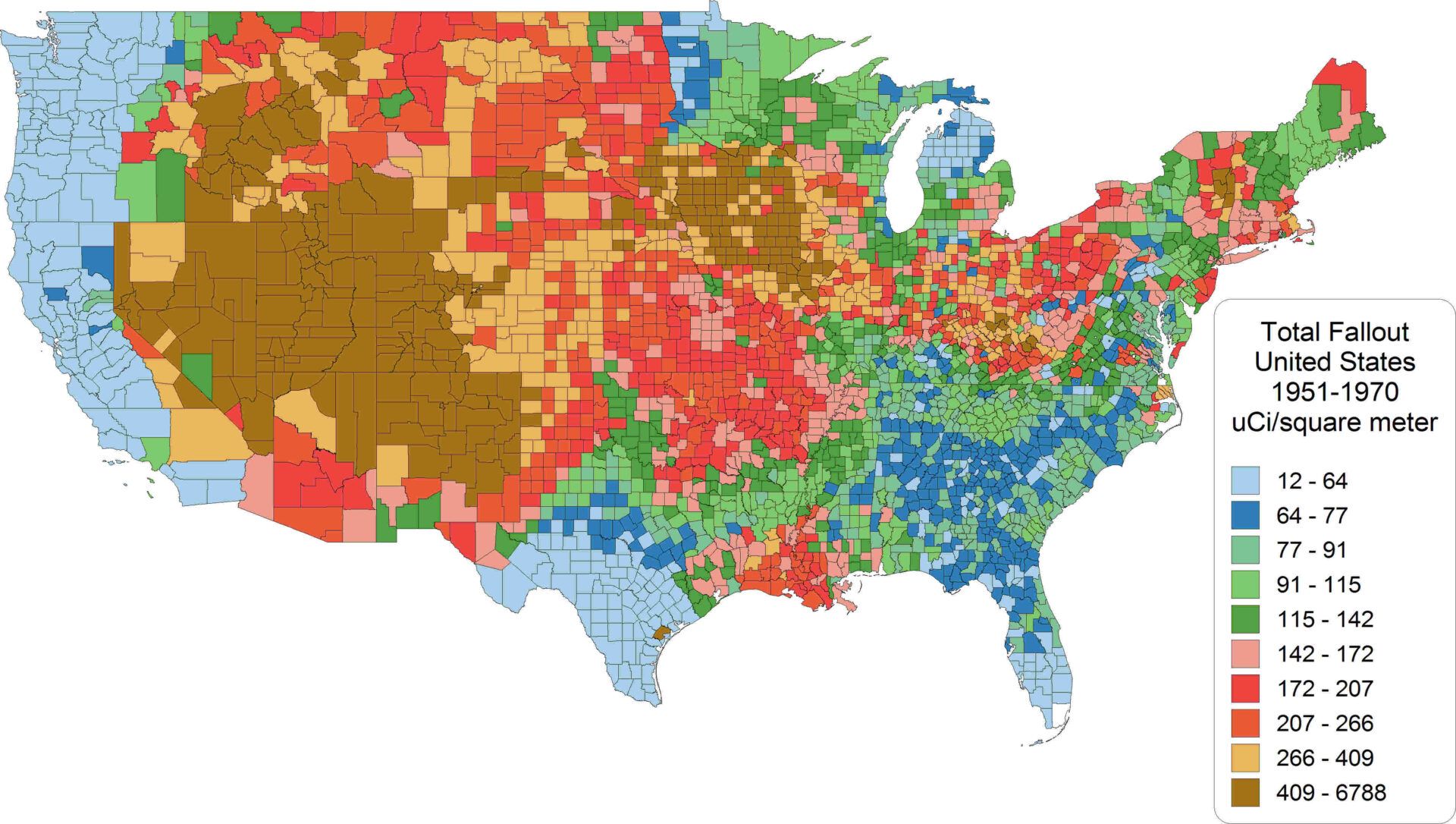
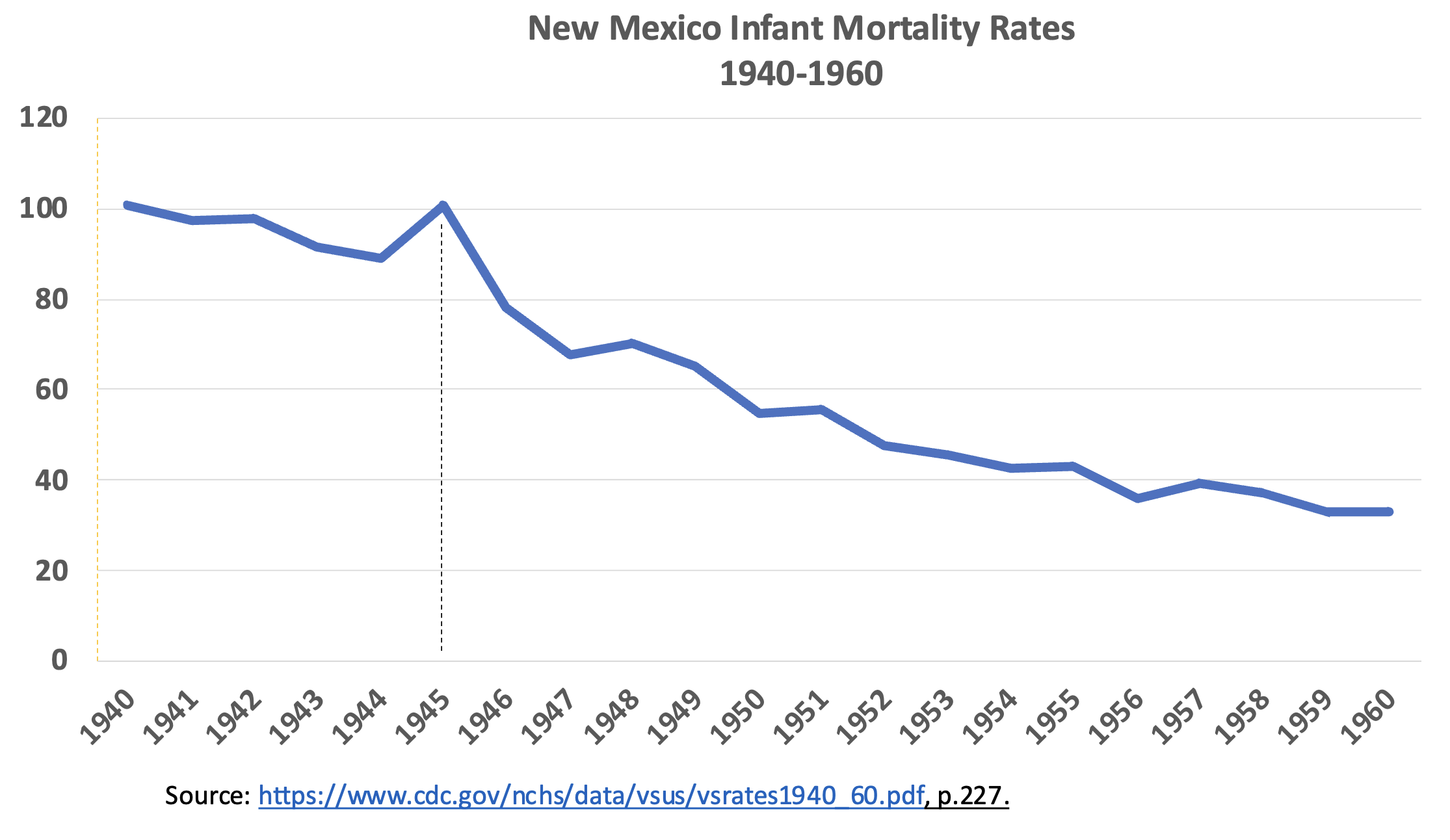
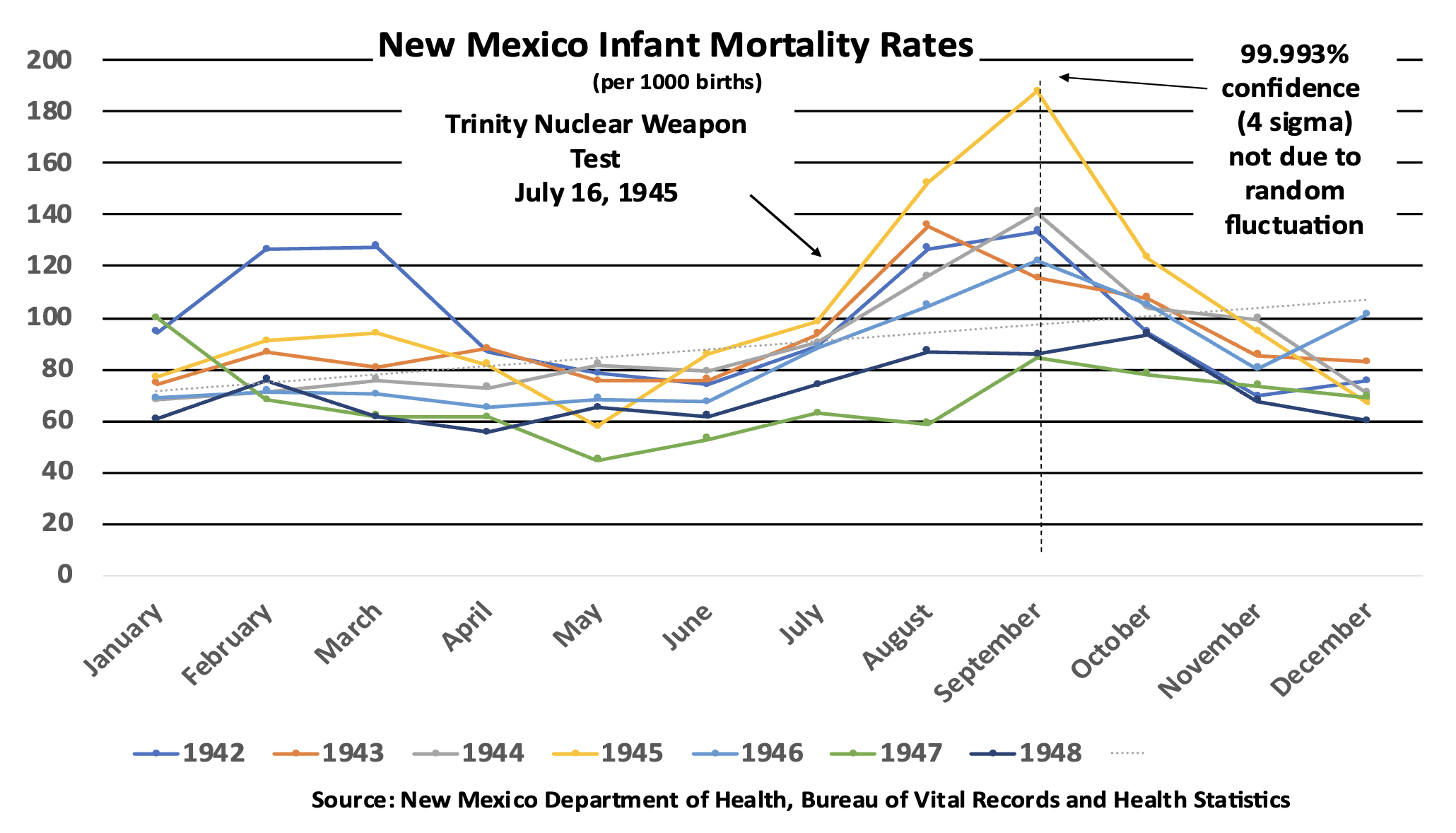
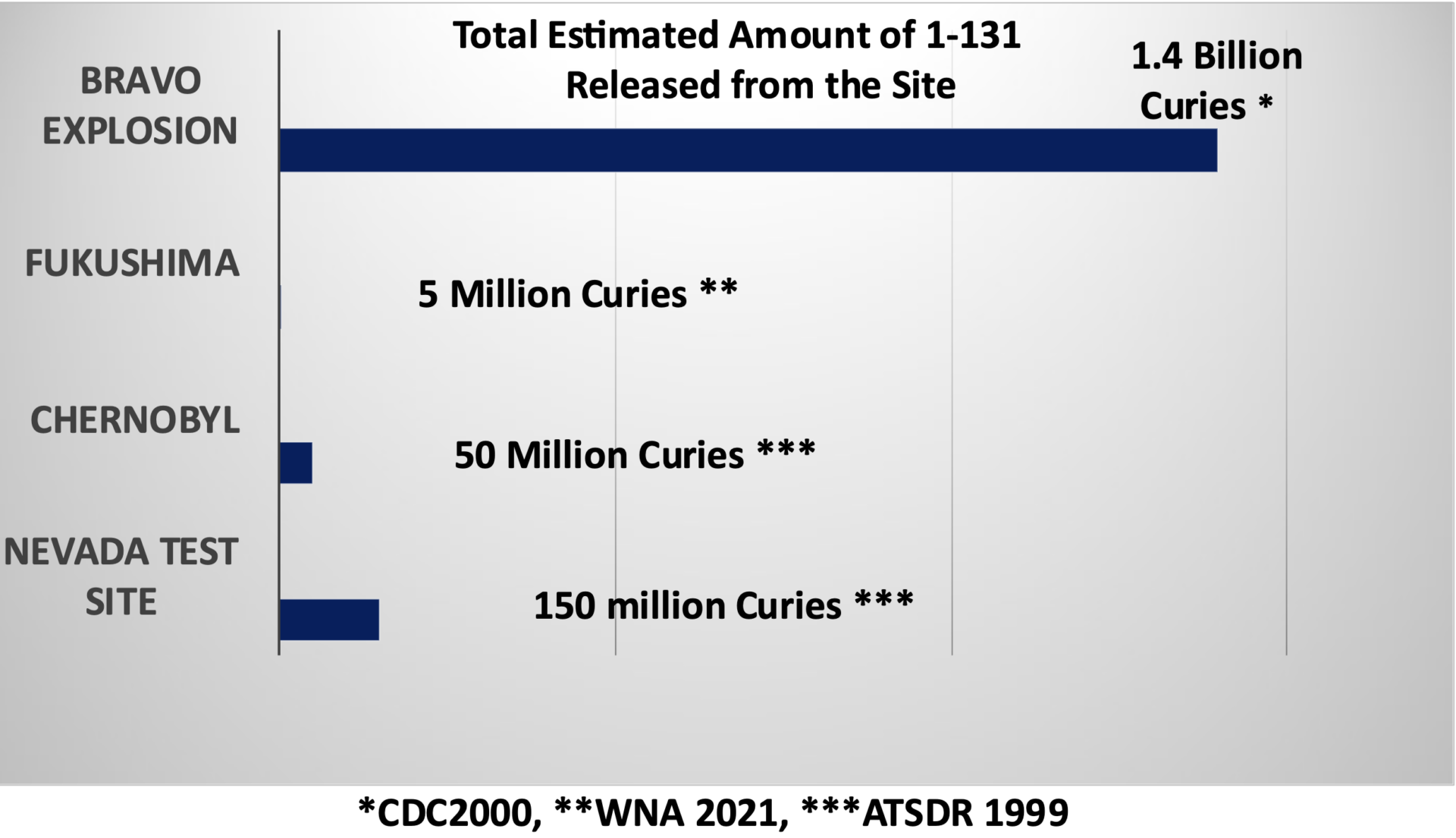

Dear Mr. Alvarez, you are a blessing. This is the most damning article I have ever read regarding the department of energy, United States military , American politicians and nuclear laboratories that I have ever read. There are numerous findings in this article that should automatically stop all nuclear programs in the United States of America.
Thank you, Mr. Alvarez, I hope you never get “reined in!” It is so important to get a true version of history told. That fallout map shows a total policy failure, contaminating almost the entire continent!
On that map, I see that the most irradiated state is Utah. In one of the stories that I came up with, a character is a woman from Utah (who later moved to New York and abandoned Mormonism). She recalls a “field trip” when she was fifteen: her whole school went and watched a nuclear test.
Yes, I’d read about how the US carried out nuclear tests on the Pacific islands, and then simply put the native peoples back on the islands, resulting in birth defects and cancers. No surprise that in 1979, Palau passed an anti-nuclear constitution.
The American people have no idea about how pervasive their exposure was to nuclear materials, even long after open air testing stopped. The Feed Materials Production Center near Fernald, Ohio discharged plutonium for years into Paddy’s Run, a tributary of the Great Miami River and thus the Ohio River. When the Office of Emergency Response in Ohio EPA became aware of this, we wanted to sample the water and sediment downstream of the site to determine what hazard existed for nearby residents. Governor James Rhodes ordered our director to specifically forbid such sampling as a “Threat to National Security.” I… Read more »